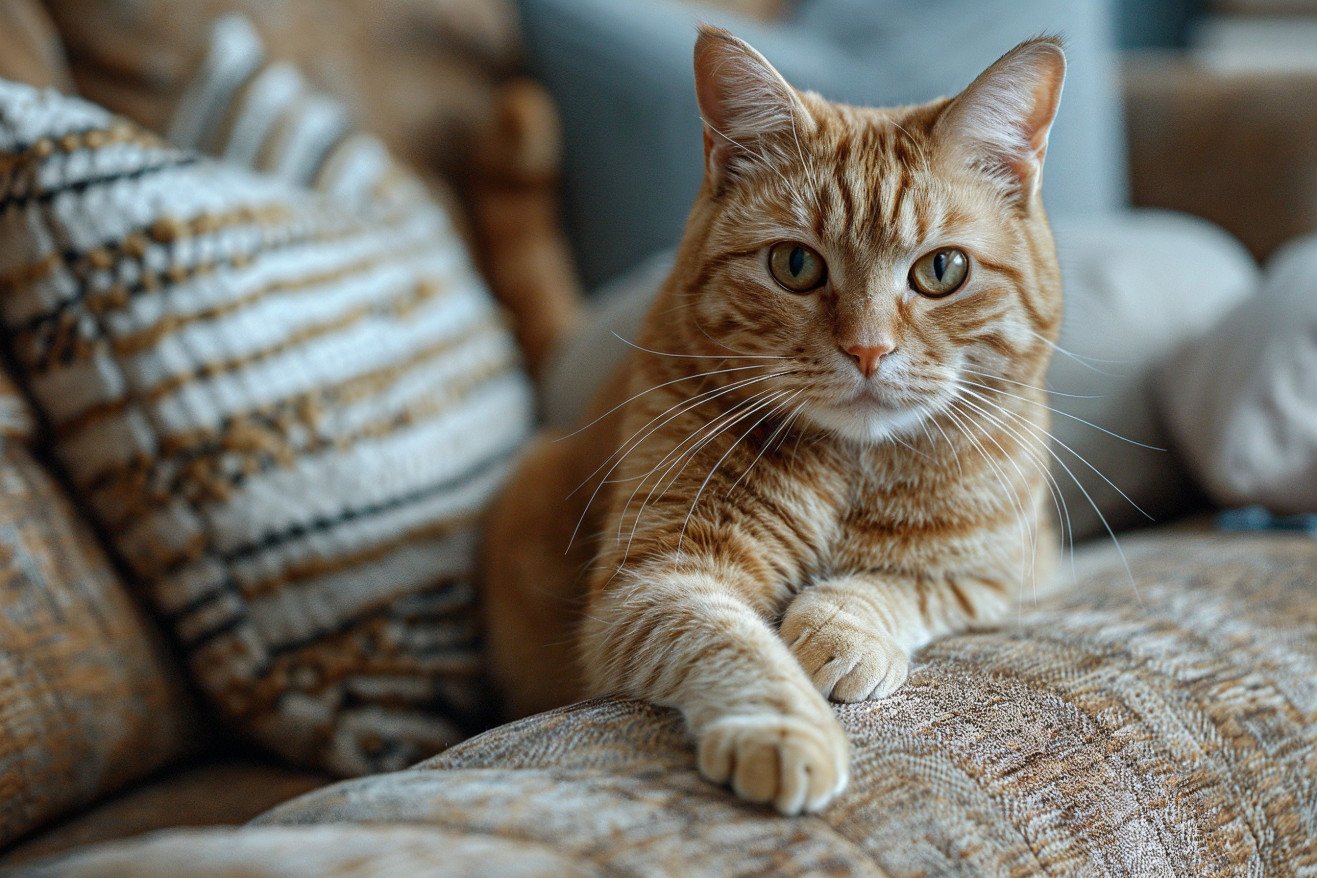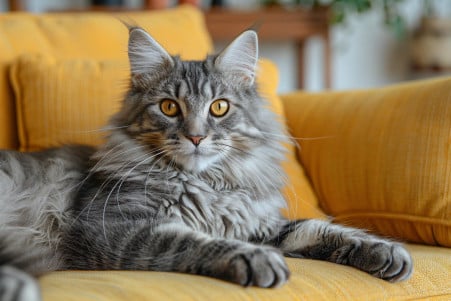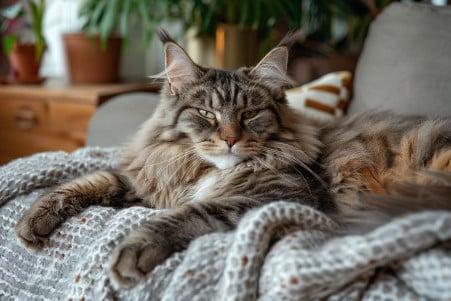Why Do Cats Knead? The Evolutionary Origins of Kneading
4 May 2024 • Updated 4 May 2024

If you've ever found yourself staring in wonder as your cat rhythmically presses its paws in and out of a blanket or your lap, you've witnessed the adorable behavior known as "kneading." This behavior is a direct result of a cat's kittenhood, when kittens kneaded their mother's stomach to stimulate milk flow during nursing. As a result, adult cats knead to show that they are comfortable, happy, or to mark you or a space with their scent.
This article will take a deep dive into the science behind this interesting cat behavior, including the evolutionary history of kneading, how it relates to cat communication and body language, and what research has to say about how to deal with this instinctual behavior if it becomes a problem. By looking at observational and scholarly research on cat behavior, you can learn more about your cat's natural instincts and form a stronger bond with your pet.
What does it mean when a cat makes biscuits?
The Evolution of Kneading
The act of kneading can be traced back to the wild ancestors of domestic cats, who would knead to flatten grass or other debris to make a comfortable place to sleep. According to Scientific American, kneading starts in kittens as a reflexive nursing behavior that helps stimulate milk flow from their mother. The repetitive motion also helps release oxytocin, which helps strengthen the bond between the mother and her kittens and makes the kittens feel more secure.
This reflexive behavior often continues into adulthood after the kitten has been weaned. Wikipedia says some researchers believe kneading is a holdover from the wild ancestors of domestic cats who would knead to make a temporary nest. Others think it's a redirected nursing behavior that helps cats bond with their human caregivers.
In addition to providing emotional comfort, kneading may also have some practical benefits. According to the Kingsdale Animal Hospital, kneading may help cats relieve stress through repetitive motion, much like a massage helps improve circulation. Cats may also knead to help release pheromones from the scent glands in their paw pads, which may help them mark their territory or a place where they feel safe and secure.
Kneading as a Sign of Comfort and Love
Kneading is often a sign that a cat feels comfortable, happy, and secure in their surroundings. As noted by Rover, cats may even direct their kneading behavior at their owners to show their love and to bond with their human. Some cats may even knead more often or harder when they are feeling especially relaxed and secure.
The Purina UK article even says that kneading may be linked to the release of oxytocin, a hormone that promotes trust and bonding. By understanding and supporting positive kneading behavior, pet parents can strengthen their relationship with their cats.
How to Deal With Problematic Kneading
Although kneading is usually a normal and sweet behavior, it can occasionally become problematic or even destructive. PetMD notes that cats who knead too much or too often may be doing so compulsively because they're stressed or anxious and the dopamine that's released when they knead encourages them to keep doing it. Cats who are in pain due to an injury or arthritis may also knead excessively to help them stretch and work out muscle tension.
To deal with problematic kneading, AAHA suggests redirecting the behavior to a more appropriate place, like a soft, thick blanket. Keeping your cat's nails trimmed can also help reduce the damage that can be caused by their sharp claws. If your cat is kneading in a place where you don't want them to, you can also use deterrents like double-sided tape or citrus-scented sprays to keep them away.
If your cat's problematic kneading is compulsive or excessive, it's important to talk to your vet or a veterinary behaviorist. According to WebMD, this kind of behavior could be a sign of an underlying medical or psychological problem that will need to be addressed by a professional. However, with the right help, pet parents can learn to identify and manage the causes of problematic kneading to help their cats live happier, healthier lives.
Differences in Kneading Behavior
There are many differences in kneading behavior among cats. For example, according to Pumpkin, some cats may knead more often than others, and some may knead more forcefully than others. Meanwhile, certain breeds, including Siamese, Tonkinese, and Balinese, are more likely to knead than others, and this is likely due to the fact that they were weaned later in life.
The Sunrise Boulevard Animal Hospital explains that female cats are more likely to knead when they are in heat or pregnant, and they do so to attract a mate or prepare a nest. Some cats use only their front paws when they knead, while others use all four paws and knead more forcefully.
Meanwhile, differences in kneading behavior, including how often a cat kneads and how forcefully they knead, can also be a sign of an underlying medical or emotional issue. For example, as Catipilla points out, kneading can be a sign that a cat is stressed or marking its territory, so differences in this behavior may warrant further investigation.
Knowing the differences in kneading behavior can help cat owners better understand their pet and make sure that they are meeting their cat's needs and helping them feel safe and secure.
Kneading and the Feline Preference for Soft Surfaces
Cats also seem to prefer to knead on soft surfaces, such as blankets, clothing, or cushioned furniture. According to BeChewy, this preference may be related to the wild cat's need to make a comfortable bed, as wild cats would have to push down grass or other plants to make a comfortable place to sleep. The softness and give of these surfaces would be similar to the feel of a mother cat's belly or a comfortable nest.
In fact, some cats may even develop preferences for certain textures when it comes to kneading. PreventiveVet explains that the need to knead on soft surfaces may be a way for cats to manipulate and flatten the material to make it more comfortable for them to lie down on.
In order to promote positive kneading and protect valuable items from damage, experts suggest that pet owners provide cats with specific places to knead, such as thick, soft blankets or furniture covers that are safe for cats. By giving cats appropriate places to meet their instinctual needs, pet owners can help cats feel more comfortable and secure in their environment.
Conclusion: Understanding and Accepting the Adorable Feline Kneading Behavior
The kneading behavior in cats, also known as "making biscuits," has evolutionary origins and is closely tied to emotional states. Female cats may knead more when they are in heat to attract mates and prepare a birthing environment. In addition, certain breeds, such as Siamese, Tonkinese, and Balinese, appear to be more prone to kneading, which may be related to the longer weaning periods they experience as kittens.
The behavior is instinctual and comes from a kitten's nursing behavior, which stimulates milk production. Cats continue to knead as adults to mark their territory with the scent glands in their paws and to create a safe and comfortable place to rest, similar to their wild ancestors who would stomp down grass or other vegetation.
Kneading is often a sign of a cat's happiness and affection, especially when they knead their owners, which may be a way to bond with humans. However, kneading that becomes excessive or problematic can be a sign of an underlying issue, such as stress or pain, that needs to be addressed by a vet.
Knowing the evolutionary and emotional roots of this adorable feline behavior can help cat owners better understand and meet their pets' needs, leading to a more rewarding and satisfying relationship.


